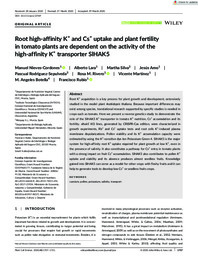Por favor, use este identificador para citar o enlazar este ítem:
https://hdl.handle.net/11000/32435Registro completo de metadatos
| Campo DC | Valor | Lengua/Idioma |
|---|---|---|
| dc.contributor.author | Nieves-Cordones, Manuel | - |
| dc.contributor.author | Lara, Alberto | - |
| dc.contributor.author | Silva, Martha | - |
| dc.contributor.author | Amo Pérez, Jesús | - |
| dc.contributor.author | Rodriguez-Sepulveda, Pascual | - |
| dc.contributor.author | Rivero, Rosa M. | - |
| dc.contributor.author | martinez, vicente | - |
| dc.contributor.author | Botella, M. Ángeles | - |
| dc.contributor.author | Rubio, Francisco | - |
| dc.contributor.other | Departamentos de la UMH::Biología Aplicada | es_ES |
| dc.date.accessioned | 2024-07-12T07:55:23Z | - |
| dc.date.available | 2024-07-12T07:55:23Z | - |
| dc.date.created | 2020-03 | - |
| dc.identifier.citation | Plant, Cell and Environmental, 2020;43:1707–1721 | es_ES |
| dc.identifier.issn | 1365-3040 | - |
| dc.identifier.issn | 0140-7791 | - |
| dc.identifier.uri | https://hdl.handle.net/11000/32435 | - |
| dc.description.abstract | Root K+ acquisition is a key process for plant growth and development, extensively studied in the model plant Arabidopsis thaliana. Because important differences may exist among species, translational research supported by specific studies is needed in crops such as tomato. Here we present a reverse genetics study to demonstrate the role of the SlHAK5 K+ transporter in tomato K+ nutrition, Cs+ accumulation and its fertility. slhak5 KO lines, generated by CRISPR-Cas edition, were characterized in growth experiments, Rb+ and Cs+ uptake tests and root cells K+-induced plasma membrane depolarizations. Pollen viability and its K+ accumulation capacity were estimated by using the K+-sensitive dye Ion Potassium Green 4. SlHAK5 is the major system for high-affinity root K+ uptake required for plant growth at low K+, even in the presence of salinity. It also constitutes a pathway for Cs+ entry in tomato plants with a strong impact on fruit Cs+ accumulation. SlHAK5 also contributes to pollen K+ uptake and viability and its absence produces almost seedless fruits. Knowledge gained into SlHAK5 can serve as a model for other crops with fleshy fruits and it can help to generate tools to develop low Cs+ or seedless fruits crops. | es_ES |
| dc.format | application/pdf | es_ES |
| dc.format.extent | 15 | es_ES |
| dc.language.iso | eng | es_ES |
| dc.publisher | Wiley | es_ES |
| dc.rights | info:eu-repo/semantics/openAccess | es_ES |
| dc.rights | Attribution-NonCommercial-NoDerivatives 4.0 Internacional | * |
| dc.rights.uri | http://creativecommons.org/licenses/by-nc-nd/4.0/ | * |
| dc.subject | caesium | es_ES |
| dc.subject | pollen | es_ES |
| dc.subject | potassium | es_ES |
| dc.subject | salinity | es_ES |
| dc.subject | transport | es_ES |
| dc.subject.other | CDU::5 - Ciencias puras y naturales::57 - Biología | es_ES |
| dc.title | Root high-affinity K+ and Cs+ uptake and plant fertility in tomato plants are dependent on the activity of the high-affinity K+ transporter SlHAK5 | es_ES |
| dc.type | info:eu-repo/semantics/article | es_ES |
| dc.relation.publisherversion | https://doi.org/10.1111/pce.13769 | es_ES |

Ver/Abrir:
Plant Cell Environment - 2020 - Nieves‐Cordones - Root high‐affinity K and Cs uptake and plant fertility in tomato.pdf
2,8 MB
Adobe PDF
Compartir:
 La licencia se describe como: Atribución-NonComercial-NoDerivada 4.0 Internacional.
La licencia se describe como: Atribución-NonComercial-NoDerivada 4.0 Internacional.
.png)